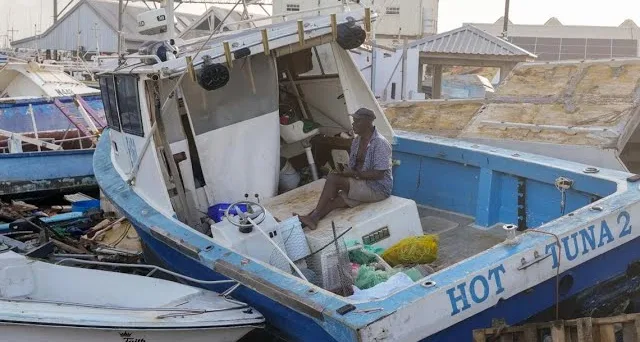Powerful Category 4 storm leaves a trail of destruction and at least six dead as it approaches Jamaica
Hurricane Beryl tore through open waters on Tuesday as a formidable Category 4 storm, now setting its sights on Jamaica after wreaking havoc across islands in the southeast Caribbean, resulting in at least six fatalities.
Jamaica, Grand Cayman, Little Cayman, and Cayman Brac are currently under a hurricane warning. Although Beryl is losing some of its intensity, it is still expected to maintain near-major hurricane strength as it nears or passes over Jamaica early Wednesday. The Cayman Islands will face the storm on Thursday, followed by Mexico’s Yucatan Peninsula on Friday, as per the National Hurricane Center.
Additionally, a hurricane watch is in place for Haiti’s southern coast and the eastern coast of the Yucatan Peninsula. Belize has issued a tropical storm watch from its border with Mexico down to Belize City.
Late Monday, Beryl became the earliest Atlantic storm to escalate to Category 5 status, peaking with winds of 165 mph (270 kph) before weakening to a still-powerful Category 4. By Tuesday night, Beryl was located approximately 300 miles (480 kilometres) east-southeast of Kingston, Jamaica, with top winds at 150 mph (240 kph) and moving west-northwest at 22 mph (35 kph), according to the National Hurricane Center.
Beryl is expected to bring life-threatening winds and storm surges to Jamaica. Officials are urging residents in flood-prone areas to prepare for possible evacuation.
“I am encouraging all Jamaicans to take the hurricane as a serious threat,” Prime Minister Andrew Holness said in a public address on Tuesday. “It is, however, not a time to panic.”
In Miami, National Hurricane Center Director Michael Brennan emphasized that Jamaica is directly in Beryl’s path.
“We are most concerned about Jamaica, where we are expecting the core of a major hurricane to pass near or over the island,” he said in an online briefing. “You want to be in a safe place where you can ride out the storm by nightfall (Tuesday). Be prepared to stay in that location through Wednesday.”
Jamaica can expect storm surges of 6-9 feet (1.8 to 2.7 meters) above normal tide levels, along with heavy rainfall, which could lead to life-threatening flash floods and mudslides, particularly in mountainous areas.
The entire southern coast of Hispaniola, shared by Haiti and the Dominican Republic, is under a tropical storm warning.
As Beryl advanced through the Caribbean Sea, rescue teams in the southeastern islands began assessing the extent of the storm’s damage. Carriacou, part of Grenada, was particularly hard hit.
Eric Blake, a senior hurricane specialist at the National Hurricane Center, mentioned in an AP interview that Beryl should no longer be a Category 5 storm by the time it approaches Jamaica.
Officials reported three deaths in Grenada and Carriacou, one in St. Vincent and the Grenadines, and two in northern Venezuela, where five individuals remain missing. In Venezuela, around 25,000 people were impacted by the heavy rainfall brought by Beryl.
Analysis
Political Perspective: The international response to Hurricane Beryl demonstrates the necessity of effective political coordination and disaster management strategies between nations. Jamaica’s Prime Minister Andrew Holness’s call for calm reflects the leadership required in times of crisis. The hurricane’s impact on various Caribbean nations also highlights the need for regional cooperation in emergency preparedness and response.
Social Perspective: The hurricane has brought communities together, as evidenced by the collaborative efforts in rescue and relief operations. Social media plays a significant role in spreading both helpful information and harmful rumors. The false information circulating on these platforms can exacerbate the already high levels of stress among affected populations, highlighting the importance of responsible communication.
Racial Perspective: While the immediate effects of the hurricane are not influenced by racial factors, the aftermath could reveal disparities in how resources and aid are distributed among different communities. Historically, marginalized communities tend to receive less attention and support during disaster recovery, an issue that authorities need to address to ensure equitable relief efforts.
Gender Perspective: In disaster scenarios, women often bear the brunt of the burden, from caring for family members to managing the logistical challenges of evacuation. The hurricane’s impact on Jamaica and other Caribbean nations will likely bring to light the gendered nature of disaster response and recovery, emphasizing the need for gender-sensitive approaches in disaster management.
Economic Perspective: The economic repercussions of Hurricane Beryl are significant. The immediate destruction of property, infrastructure, and crops will have long-term effects on the local economies of the affected islands. Tourism, a critical industry for many Caribbean nations, will likely suffer as well, further straining the economic recovery efforts. Additionally, the financial burden on families to rebuild and the costs associated with ongoing search and rescue operations highlight the extensive economic impact of such natural disasters.
